Understanding Nail Blackening: Causes and Care
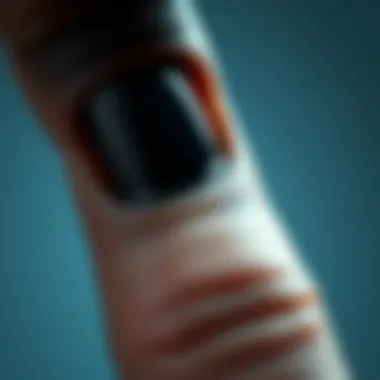
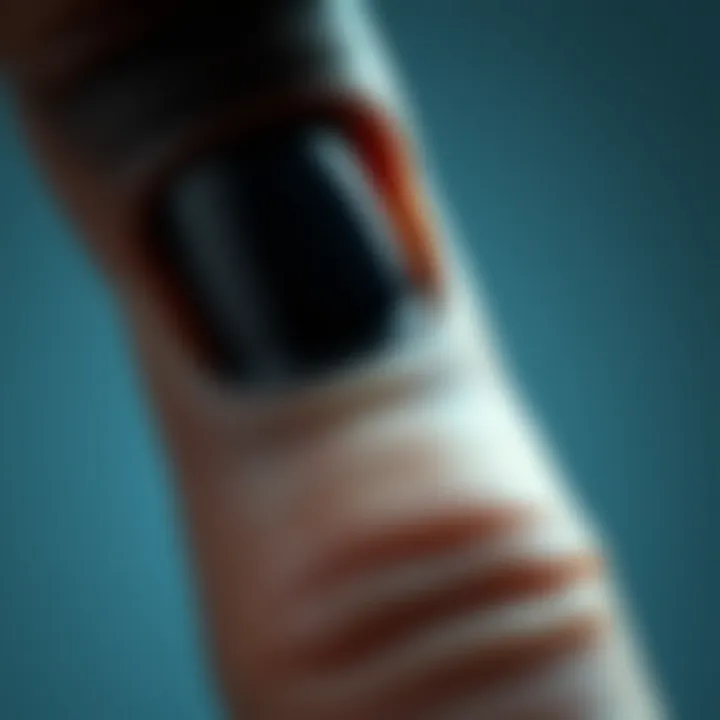
Intro
The blackening of nails might seem like a mere nuisance, yet it can be indicative of deeper health concerns. Focusing on nail discoloration, particularly blackened nails, can shed light on various underlying issues, thereby guiding appropriate responses and treatment. Understanding the causes is essential, as it ranges from benign injuries, such as a stubbed toe, to more serious conditions like melanoma. The importance of this knowledge cannot be overstated, particularly for health professionals, wellness coaches, and others in the healthcare arena who seek to guide individuals through their health challenges.
With so many factors potentially at play, it’s vital to approach nail discoloration with a careful eye. This article will take a closer look at how lifestyle choices, injuries, and medical conditions contribute to the discoloration, the potential implications of changes in nail appearance, and effective management strategies to promote optimal nail health.
Causes of Blackened Nails
The reasons why nails might take on a black hue are varied and multifaceted. When investigating blackened nails, consider the following common causes:
- Trauma or Injury: One of the most frequent culprits behind blackened nails is trauma. A friend might share a story about how they slammed their finger in a door, resulting in a black nail. In such cases, blood may pool beneath the nail, leading to that darkened appearance.
- Fungal Infections: Sometimes, what appears to be a blackened nail can result from a fungal infection, leading to discoloration and possibly an unpleasant odor. This often requires antifungal treatment to resolve effectively.
- Medical Conditions: A range of health issues can result in nail discoloration. For instance, certain medications can cause adverse effects, including nail darkening. Additionally, more severe ailments such as melanoma cannot be overlooked.
- Nutritional Deficiencies: The absence of vital nutrients, such as zinc or biotin, can lead to various nail disorders, including discoloration. Maintaining a balanced diet can play a significant role in preventing such issues.
Diagnostic Approaches
Understanding the cause of blackened nails typically involves a careful evaluation:
- Patient History: A thorough discussion regarding the onset, duration, and any additional symptoms is essential, as it provides a clear picture of the potential underlying causes.
- Physical Examination: A healthcare provider may examine the nails, skin, and overall health to identify any visible signs of infection or other conditions.
- Laboratory Tests: Depending on the suspected cause, tests such as blood work or a nail sample may be necessary to confirm fungal infections or nutritional deficiencies.
This multifaceted approach to diagnostics ensures that the actual problem can be pinpointed rather than guesswork leading the way.
Implications of Nail Discoloration
The implications of blackened nails extend beyond physical aesthetics. Nails serve as indicators of overall health. Discoloration might signal nutritional deficiencies or early signs of disease, prompting necessary lifestyle adjustments or medical interventions.
Furthermore, the psychological effects of nail discoloration should not be neglected. Individuals experiencing visible changes in their nail health may feel embarrassed or self-conscious, which can affect their overall well-being. Therefore, addressing the physical symptoms alongside emotional response is paramount.
Management Strategies
Taking care of one’s nails involves both at-home remedies and seeking professional help where necessary:
- At-Home Remedies: For minor injuries, cold compresses may alleviate pain and swelling. Keeping nails trimmed and clean can also prevent additional problems.
- Diet Improvement: Incorporating more whole foods, rich in vitamins and minerals, can support nail health. Emphasizing leafy greens, nuts, and seeds can bridge nutritional gaps.
- Professional Treatments: In cases of persistent discoloration due to conditions like fungal infections, consulting a doctor for appropriate prescriptions or treatments is essential.
In summary, understanding the blackening of nails is a vital endeavor for anyone concerned about their health. By exploring potential causes, diagnosing correctly, understanding implications, and managing effectively, individuals can take charge of their nail health, leading to a more confident and healthier life.
For further insights, consider exploring resources from Mayo Clinic, which delves into similar topics, or check WebMD for comprehensive healthcare advice.
Prologue to Nail Health
Nail health is often an overlooked aspect of overall wellness, yet it carries significant weight in understanding various underlying conditions. Healthy nails do more than just enhance one's appearance; they serve as a window into the body's systemic health. When issues arise, such as discoloration, they can be an early indicator of medical conditions requiring attention.
In this conversation about nail blackening, it becomes crucial to recognize why maintaining healthy nails is essential. Strong and well-cared-for nails can prevent the onset of infections and injuries. Discoloration or abnormalities often speak volumes, revealing insights into dietary imbalances, circulatory issues, or even injuries that might seem trivial at first glance.
Importance of Healthy Nails
Healthy nails are a reflection of our well-being. They aren't just superficial; they can signify how our body is functioning beneath the surface. When nails exhibit good health, they tend to be smooth, with no ridges or spots, and they maintain a consistent color. A person's nutrition, hygiene practices, and lifestyle choices all influence nail health. For example, diets lacking in essential vitamins like biotin or calcium can lead to brittle or soft nails that may break or peel easily.
Moreover, healthy nails play a protective role. They shield the delicate tips of our fingers and toes from physical trauma and infection. Infestations or fungal infections can quickly take root in unhealthy nails, further complicating nail care.
Significance of Nail Appearance
- Physical Protection: Good nails provide a barrier against environmental aggressors.
- Health Indicator: Changes in nail color or texture can indicate stress or illness.
- Aesthetic Value: Healthy nails contribute to one's overall appearance and self-esteem.
What Nail Discoloration Indicates
Nail discoloration often serves as a telltale sign of various health issues. Blackened nails, for instance, can be caused by trauma or minor injuries, but they might also allude to something more serious lurking beneath the surface. Therefore, understanding what these changes signify is key to proactively addressing potential health concerns. When diagnosing the root cause, factors such as the onset of discoloration, accompanying symptoms, and personal health history should be considered.
- Common Indicators of Concern: A sudden change in color, especially if paired with other symptoms like pain or swelling, can indicate an underlying issue.
- Differentiating Factors: Distinguishing between traumatic and pathological causes of nail blackening is crucial. For instance, a blackened nail after stubbing a toe may differ significantly from one affected by a medical condition such as melanoma.
"Nails are more than just keratin. They are a reflection of our internal state, often revealing what our bodies endure, both visibly and invisibly."
Recognizing the nuances of nail health allows individuals to take proactive measures. By maintaining awareness and understanding the implications of discoloration, one fosters a deeper connection with their body, paving the way for better health outcomes.
Defining Blackening of Nails
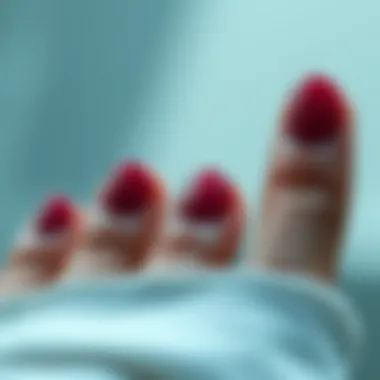
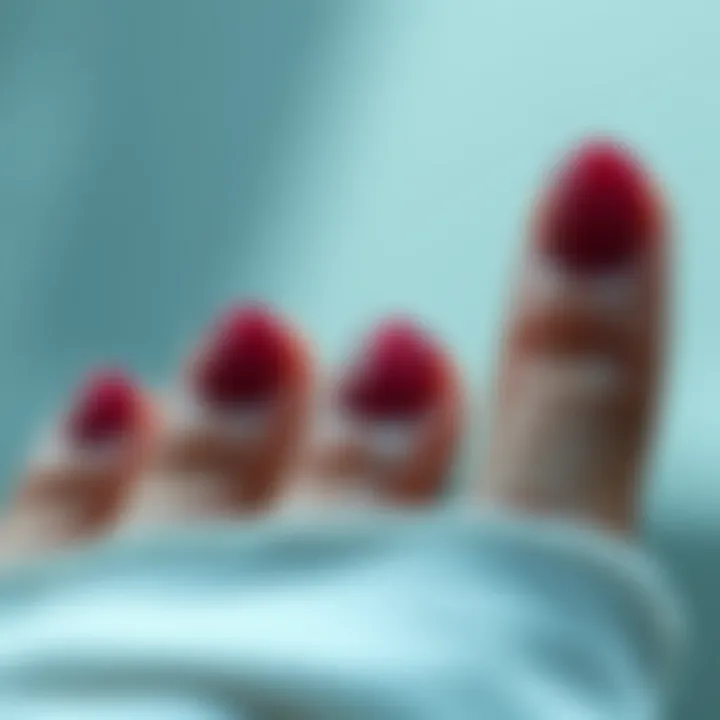
Understanding the blackening of nails is not merely about recognizing a color change; it opens up a dialogue about overall nail health and what it signifies about one’s bodily condition. This section aims to clarify the elements that constitute blackened nails, while highlighting the importance of differentiating them from benign discolorations and more serious conditions. Recognizing when a nail's appearance shifts can be crucial.
Characteristics of Blackened Nails
When examining a blackened nail, several characteristics can help in defining the condition. Take note of the following features:
- Color Variation: While the predominant shade is often a deep black, it can sometimes present as dark brown or even a purplish hue.
- Texture Changes: The nail may feel different, possibly becoming thicker or appearing lifted from the nail bed.
- Associated Symptoms: Look for accompanying signs such as swelling, pain, or discharge, as these can indicate a more serious condition.
It’s worth noting that blackened nails can stem from various origins, each carrying its particular implications for treatment or management. For instance, a blackened nail due to trauma will likely differ significantly in treatment from one caused by a fungal infection.
Distinguishing Between Causes
Differentiating the causes behind blackened nails is vital in determining the appropriate response. Here are crucial factors to consider:
- Traumatic Injuries: Nails can turn black as a reaction to an impact. A common scenario is stubbing a toe, which often leads to bruising beneath the nail. The injury can create a classic black appearance due to blood pooling underneath.
- Fungal Infections: On the other hand, fungal infections may present a similar discoloration but are typically coupled with a foul odor or crumbly texture. These typically require antifungal treatments.
- Underlying Medical Conditions: It’s essential to be vigilant about other health conditions that present with blackened nails. For instance, melanoma can be a serious concern if the discoloration occurs without a clear external cause.
- Chemical Exposure: Certain chemicals can cause the nail to darken. This is often seen in people regularly exposed to harsh solvents or toxic compounds in occupations requiring extensive contact with various substances.
Recognizing the distinctions between these causes not only informs the correct treatment approach but can also highlight broader health concerns that one may have otherwise overlooked.
The appearance of a nail can be a window into someone's health. Pay attention to changes and consider them signals rather than mere aesthetic concerns.
In summary, defining the blackening of nails involves an integrated understanding of various characteristics and causes. Each factor not only guides the diagnostic process but also proposes potential treatment paths, emphasizing the need for diligence in monitoring any changes in nail health.
Common Causes of Blackening of Nails
Understanding the various factors that lead to the blackening of nails is crucial not only for maintaining nail health but also for identifying potential underlying issues that could affect overall well-being. Recognizing the causes provides clarity on when to seek medical advice and what preventive strategies can be implemented. Nail discoloration can stem from a range of sources, each demanding a unique approach to treatment or management. This section delves into the most common contributors, offering insight into their implications and the attention they warrant.
Traumatic Injuries
Traumatic injuries often act as the most straightforward explanation for blackened nails. These incidents can occur during sports, accidents in the home, or even from nail-biting habits. When a nail sustains a blow or is pinched, blood may collect beneath it in a condition known as subungual hematoma, leading to dark pigmentation.
The color can vary depending on the severity of the trauma; it might start as a reddish hue and progress to a deeper purple or black. While these marks are usually benign, they can cause pain and discomfort and may sometimes necessitate medical intervention if pressure builds up underneath the nail.
Fungal Infections
Fungal infections can also be a significant player in the blackening of nails. The most common type, known as onychomycosis, can lead to changes in nail color, texture, and overall appearance. These infections tend to thrive in moist environments, making individuals who frequently expose their hands and feet to water particularly vulnerable.
The characteristic that sets this issue apart is that it might start subtly but gradually leads to a complete degradation of nail integrity. The nail may appear thickened, brittle, and discolored. Treatment often requires antifungal medications, and maintaining proper hygiene as a preventive measure is essential.
Underlying Medical Conditions
Certain systemic diseases can manifest themselves through nail discoloration, and this includes several serious conditions.
Melanoma
Melanoma, although primarily recognized as a skin cancer, can also present itself under the nails. The condition may cause a dark stripe running along the length of the nail, called a longitudinal melanonychia. This is distinguishable from other causes due to its potential rapid progression and the sense of urgency it invokes. Factor to consider is that early detection is paramount in managing melanoma adequately.
Psoriasis
Psoriasis is another condition that can affect nail health, leading to pitting, discoloration, and sometimes separation from the nail bed. The hallmark feature here is the scaly patches associated with the condition, which often correlate with the changes observed in the nails. Treatment typically focuses on managing the broader symptoms of psoriasis while also addressing nail-specific issues through topical therapies.
Circulatory Issues
Circulatory issues are sometimes indicated by changes in nail color. Conditions like peripheral artery disease can restrict blood flow and lead to discolored nails. The key characteristic in these cases is often combined with additional symptoms such as cold extremities or skin changes. Recognizing this link underscores the significance of circulatory health in maintaining overall nail and skin appearance and health.
Chemical Exposure
Chemical exposure could contribute to the darkening of nails, particularly for those who work with harsh cleaning agents or other toxic substances. Frequent contact with these chemicals can lead to damage and discoloration, marking the need for protective measures.
Important Note: If exposure to chemicals is suspected as the root cause, it’s paramount to minimize direct contact and consider seeking dermatological advice.
Diagnostic Approaches to Blackened Nails
Understanding how to diagnose the blackening of nails is critical for identifying underlying issues early on. This section elaborates on both the clinical evaluation and laboratory tests, highlighting their significance in determining the appropriate course of action. Given the variety of potential causes, from minor trauma to serious conditions like melanoma, a systematic approach to diagnosis is imperative for effective treatment.
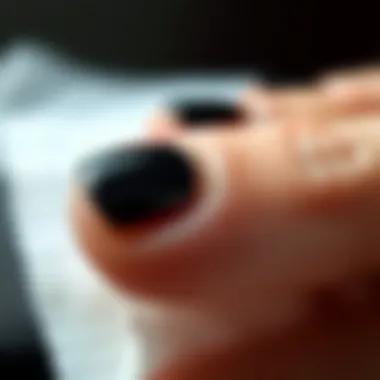
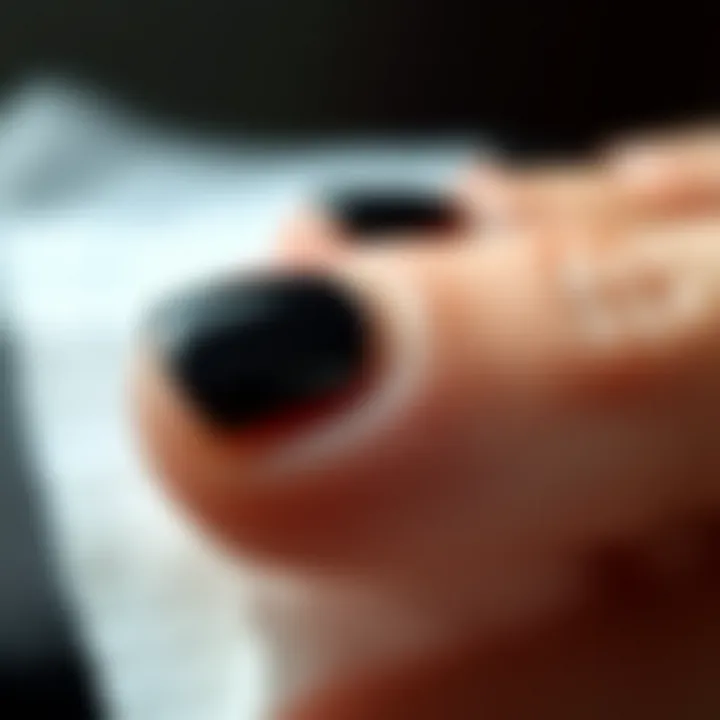
Clinical Evaluation
When it comes to assessing blackened nails, clinical evaluation stands as the first line of investigation. Health professionals often initiate with a thorough history and physical examination. During this process, they’ll ask about:
- Symptoms: Have you noticed pain, swelling, or changes in nail texture?
- Recent Injuries: Did you suffer any trauma to the fingernails or toenails?
- Medical History: Do you have pre-existing conditions such as psoriasis or circulatory problems?
- Environmental Factors: Have you been exposed to certain chemicals or substances that could affect nail health?
An attentive clinician will assess the nail's color, texture, and overall health, looking for signs that might suggest specific conditions. For example, they might distinguish between a bruise from impact and a discoloration related to an infection. Furthermore, a careful examination can reveal other nail abnormalities, signaling the need for more in-depth investigation.
Laboratory Tests
In some cases, a clinical evaluation might not provide enough clarity, necessitating laboratory tests for more conclusive results. Several tests may be employed to understand the underlying cause of nail blackening:
- Nail Culture: If a fungal infection is suspected, a sample may be sent for culture to identify the type of fungus involved.
- Biopsy: In uncertain cases, a small sample of the nail and surrounding tissue might be excised for histopathological analysis, especially to rule out malignancies.
- Blood Tests: Various blood tests can assess for systemic conditions that might affect nail health, such as circulatory issues or autoimmune diseases.
These laboratory assessments provide a deeper understanding of the nail's condition, confirming or ruling out potential issues that a clinician might suspect based on the visual evaluation. Ultimately, the combination of clinical evaluation and lab tests equips health professionals with the necessary tools to formulate a targeted treatment strategy, enhancing the likelihood of effective recovery.
"Prompt diagnosis is often the bridge between a mere inconvenience and a serious health concern; knowing when to consult a professional could save you from escalating issues."
By investing time in these diagnostic methods, there is a greater chance of catching more severe underlying conditions early, thus facilitating a timely and effective management plan.
When to Seek Medical Attention
Understanding when to seek medical attention for blackened nails is crucial. Early recognition of troubling signs can greatly impact outcomes, especially in serious conditions such as melanoma or circulatory problems. If you find yourself wondering whether the appearance of your nails is just a minor inconvenience or a signal of something more serious, it’s always better to err on the side of caution. Prompt medical intervention can often prevent further complications and foster better treatment options.
Identifying Symptoms of Concern
Awareness of the symptoms that warrant immediate medical evaluation is fundamental. While not every case of nail discoloration signifies a severe health issue, some signs are particularly indicative of underlying problems. Here are a few symptoms of concern that you shouldn’t ignore:
- Significant changes in color: If the blackening is accompanied by other colors like yellow or green, this could indicate a fungal infection or other infection.
- Pain or discomfort: When nails begin to ache, especially without obvious reasons like trauma, it could suggest complications that require medical thought.
- Thickening or swelling: Changes in the nail's thickness or adjacent swelling may hint at nail bed infections or serious conditions such as psoriasis.
- Bleeding or pus: Any discharge, particularly pus or blood, should prompt immediate attention as it can signify an infection.
- Accompanying systemic symptoms: Fever, unexplained weight loss, or fatigue can suggest a broader health concern.
Recognizing these signs can help delineate normal changes from worrisome symptoms.
Understanding Urgency
Not all blackened nails require a trip to the doctor, but understanding the urgency behind the symptoms can guide your decision. If you notice the symptoms discussed above, consider the following steps:
- Visual assessment: Gauge the extent of the blackening. Is it localized, or does it encompass multiple nails? Localized issues might be less urgent than widespread ones.
- Duration: How long have the symptoms persisted? Changes that don’t clear up in a few days should not be ignored.
- Prior health conditions: If you have a history of nail issues, circulatory problems, or autoimmune diseases, you may need to be cautious.
If anything feels off, trust your instincts. As a general practice, it is wise to schedule a consultation with a healthcare provider if symptoms persist or worsen.
"Early detection is paramount in managing health concerns effectively. It’s sensible to take note when more than just color changes occur."
For further information on nail health and conditions, consider exploring reputable resources like Healthline or Mayo Clinic.
Understanding when to seek help is not merely about responding to aesthetic concerns but recognizing potential health signals that could impact your overall well-being.
Management and Treatment Options
Managing the blackening of nails is a multifaceted task. Understanding the treatment options available is crucial not just for alleviating symptoms but for addressing the root cause. Appropriate management can prevent further complications and improve overall nail health. When dealing with any form of nail discoloration, considerations such as severity, underlying causes, and individual health conditions play a significant role.
Home Remedies
Natural Oils and Moisturizers
Natural oils and moisturizers serve as an accessible and often effective approach for maintaining nail health in the face of blackening. Oils like coconut or almond oil, for instance, are packed with nutrients that can boost keratin production in the nails, promoting overall strength and resilience. Their lightweight texture allows for easy absorption, providing both hydration and a protective barrier against environmental stressors.
The key characteristic of these oils lies in their natural emollient properties. They nourish the nails while softening cuticles, making them less prone to breakage. Because they are cost-effective and easy to find, many people embrace them as a popular choice for fostering healthy nails.
However, while natural oils are beneficial, they are not a cure-all. In some cases, particularly when serious underlying health issues are present, oils alone may lack the therapeutic effect needed for significant improvement. Additionally, users should be aware of potential allergies that can arise from certain plant oils, making it essential to patch-test before consistent use.
Protective Measures
Protective measures encompass a range of proactive strategies aimed at keeping your nails safe from blackening and further injury. Wearing gloves during household chores or while using harsh chemicals is one fundamental practice that can safeguard your nails. This approach directly contributes to the overall topic of maintaining nail health by minimizing the risk of trauma and reducing exposure to harmful substances.
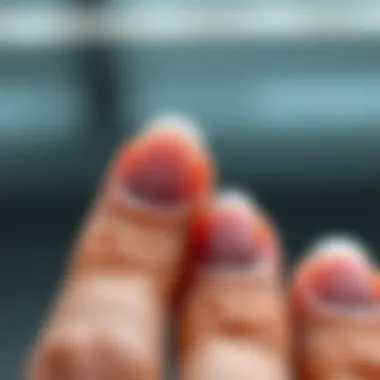
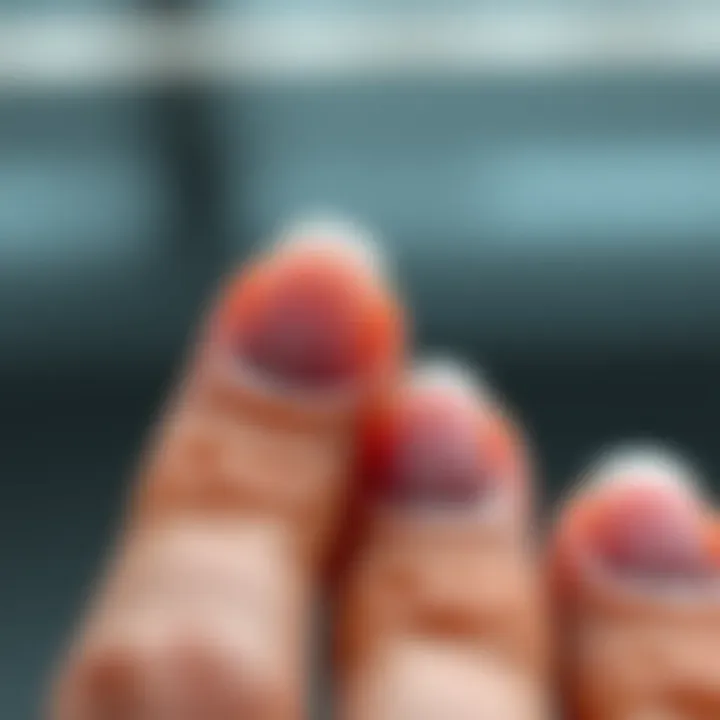
The key characteristic of these protective measures is their straightforward applicability. For anyone concerned about their nails, these methods represent an immediate and effective way to reduce risk factors. Using protective gear is not just a smart choice but a necessary one for maintaining healthy nails.
Yet, protective measures do come with downsides. Some individuals may find gloves cumbersome or too hot, particularly in warmer environments. Furthermore, neglecting to combine these protective strategies with proper nail care may limit their effectiveness in addressing the blackening of nails.
Professional Treatments
Nail Surgery
Nail surgery can be a vital part of managing serious cases of blackened nails, especially when conservative treatments fail. This procedure can involve removing part or all of the nail to treat infections, tumors, or persistent conditions like ingrown nails. Such surgical intervention may be necessary to alleviate pain and prevent further complications, underscoring its role in the overall treatment landscape.
A key characteristic of nail surgery is its ability to provide immediate results for severe cases. Patients often experience rapid relief following the procedure, making it a beneficial option for those in acute distress. However, the need for surgery should not be taken lightly. On the downside, there are risks accompanying surgical procedures, such as infection or delayed healing, which need to be considered carefully.
Prescription Medications
Prescription medications are another avenue for tackling the blackening of nails, particularly when infections or underlying conditions need medical intervention. Options such as antifungal treatments or oral medications for skin conditions can play a critical role in restoring nail health. In cases where a serious condition is identified, these medications may be the key to reversing nail discoloration effectively.
The unique feature of prescription medications lies in their targeted approach. They can treat specific conditions that contribute to nail discoloration, making them a vital resource for healthcare providers. Furthermore, their potency often leads to quicker results compared to home remedies. However, individuals must be aware of the potential side effects that can accompany these treatments. Relying solely on pharmaceuticals without adopting holistic lifestyle changes may not yield the desired long-term results.
"Understanding and managing blackening of nails is not a one-size-fits-all scenario; it demands individualized attention and a strategic approach to treatment choices."
Adjusting treatment strategies as needed based on the individual's response becomes vital. For those seeking effective ways to manage their nails' health, a combination of home remedies and professional interventions may yield the best outcomes.
Preventive Measures to Maintain Nail Health
Maintaining healthy nails is not just about aesthetics; it is a reflection of overall health and wellness. The significance of preventive measures cannot be overstated, especially in avoiding complications associated with nail discoloration, such as blackened nails. A proactive approach can significantly reduce the risk of ailments, leading to healthier nails and better clarity on underlying health issues.
Proper preventive measures encompass both lifestyle choices and nail care practices, contributing immensely to the health status of your nails. By incorporating certain habits into daily life, individuals can promote strong and beautiful nails while minimizing the potential for damage or discoloration.
Healthy Lifestyle Choices
Adopting a healthy lifestyle is foundational to nail health. This involves more than just an external approach, extending deeply into nutrition and overall well-being. A few pivotal factors include:
- Balanced Diet: Consuming a nutrient-rich diet is essential. Foods high in vitamins like B, C, and E, as well as minerals such as zinc and iron, contribute to nail strength. Incorporating lean proteins and plenty of fruits and vegetables can provide the essential building blocks for your nails.
- Hydration: Staying hydrated is key to maintaining nail moisture and flexibility. Dehydration can lead to brittle nails that are prone to breakage. Aim for at least eight glasses of water a day to promote good hydration.
- Regular Exercise: Physical activity not only bolsters circulation but also contributes to overall health, impacting nail growth positively. Exercise aids in delivering nutrients to the extremities, including your nails.
“A healthy body fosters healthy nails.”
- Avoiding Harmful Substances: Limiting alcohol consumption and quitting smoking can also play a crucial role. Both habits can negatively affect circulation and thus impact nail health and appearance.
In essence, cultivating healthy lifestyle choices can fortify your nails from the inside out, reinforcing their resilience against damage and discoloration.
Proper Nail Care
Proper nail care is equally vital in preventing the blackening of nails. Implementing a straightforward nail care routine sets the stage for optimal nail health. Key practices include:
- Regular Trimming: Keeping nails trimmed and shaped not only prevents snagging and breaking but also helps maintain their aesthetic appeal.
- Moisturizing: Just like skin, nails benefit from moisture. Using natural oils, such as coconut or jojoba oil, can help keep nails hydrated and supple, preventing cracking or brittleness.
- Avoiding Harsh Chemicals: Steering clear of strong chemical agents in nail products can significantly reduce the risk of damage. Always opt for more gentle formulations when possible.
- Using Protective Gloves: When doing household chores or working with chemicals, wear gloves to shield your nails from potential harm or discoloration.
- Healthy Nail Polishing Practices: If you enjoy nail polish, utilize breathable formulas or let your nails rest in between applications to prevent them from becoming weak.
- Regular Cleanliness: Keeping your nails clean and free from debris not only looks good but helps in preventing infections that could lead to discoloration.
By taking these proper nail care steps, individuals can effectively fend off potential risks associated with nail blackening and promote healthier nails overall.
In summary, preventive measures serve as a cornerstone for maintaining nail health. By embracing healthy lifestyle choices and incorporating diligent nail care, you can significantly reduce the risks associated with nail discoloration while ensuring that your nails remain a symbol of health and vitality.
Finale
Drawing from the intricate exploration of nail health throughout this article, we come to a pivotal understanding of the blackening of nails. This topic sheds light not only on the various underlying causes—ranging from innocuous injuries to grave medical conditions—but also emphasizes the importance of recognition and timely intervention.
Summary of Key Points
- Variety of Causes: We uncovered that blackening can stem from traumatic injuries, fungal infections, or medical conditions like melanoma. Each cause has its unique identifier, providing pathways for observation and further examination.
- Diagnostic Approaches: The process of diagnosis involves clinical evaluations and lab tests, ensuring that neither significant conditions nor subtle signs are overlooked.
- Management Options: Effective management strategies from home remedies to professional treatments have been highlighted. Simple actions can make a world of difference in maintaining nail health.
- Preventive Measures: Emphasis on healthy lifestyle choices and proper nail care is critical for preventing future issues. Understanding these elements contributes significantly to long-term health.
Emphasizing Ongoing Care and Monitoring
To maintain nail health, it’s crucial to adopt a routine that emphasizes ongoing care and monitoring. Regular checks on nail condition can reveal early signs of trouble, providing an opportunity to act before issues escalate.
- Consistent Observation: Keep an eye on changes in nail color or texture. Even minor shifts can be a signal of underlying issues.
- Healthy Routine: Establishing a regular nail care routine, which includes moisturizing and protecting nails, goes a long way in sustaining their integrity.
- Seek Professional Advice: When in doubt, do not hesitate to consult a healthcare provider. Their expertise can pinpoint problems that might not be evident otherwise.
By embracing these practices, not only can individuals prevent conditions leading to nail blackening, but they can also enhance overall health and wellbeing. For those in health-related fields, nurturing a holistic approach adds immense value to client care, highlighting the interconnectedness of nail health with broader health parameters.
"Ongoing vigilance in nail health isn’t just about aesthetics; it reflects deeper physiological states that deserve attention."
For additional resources: Wikipedia on Nail Health, National Institutes of Health and Healthline.



